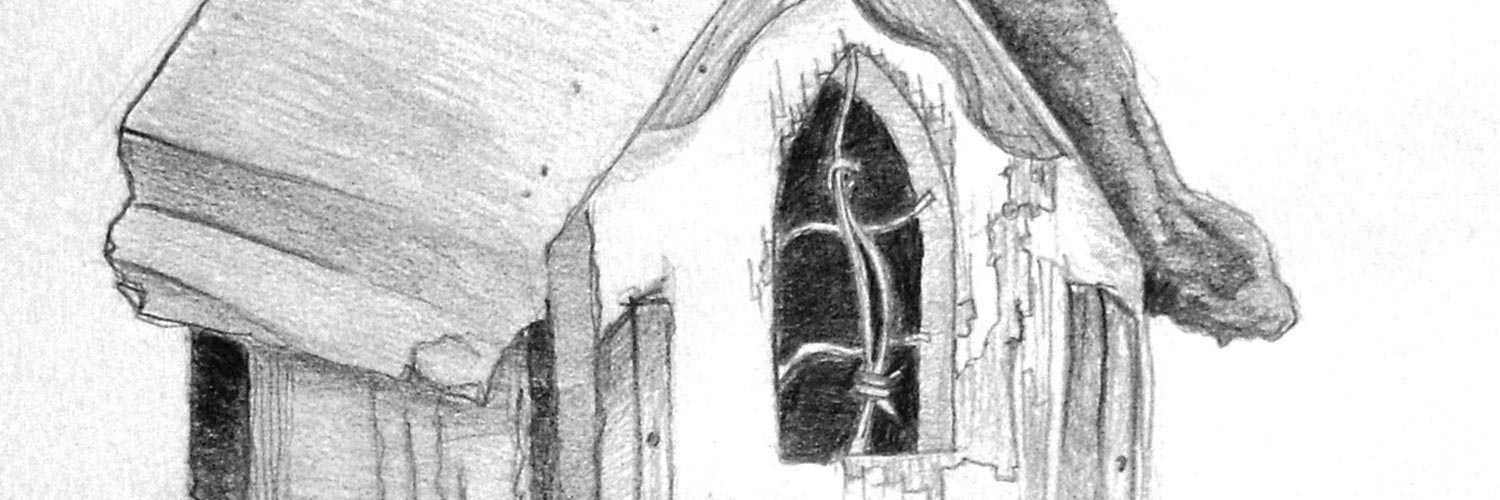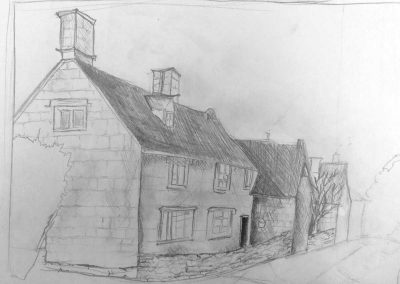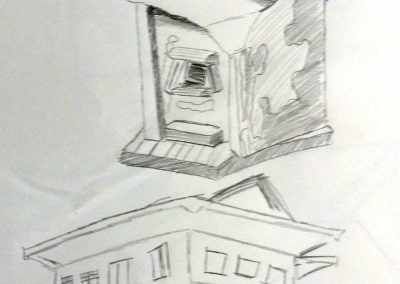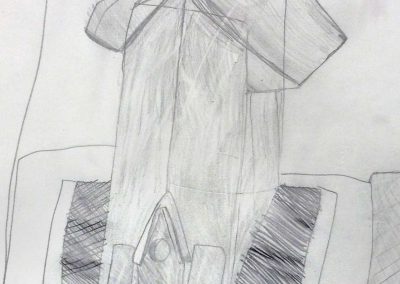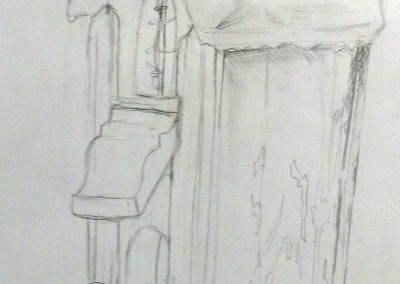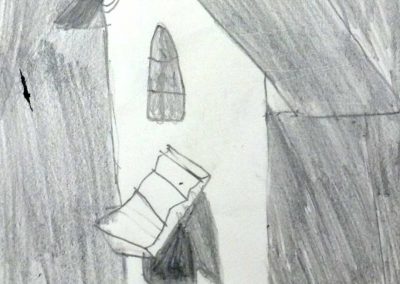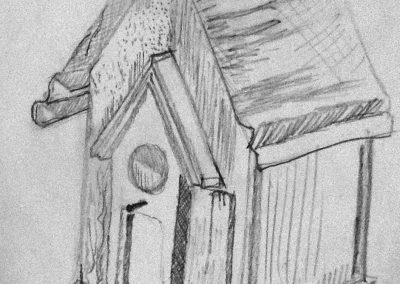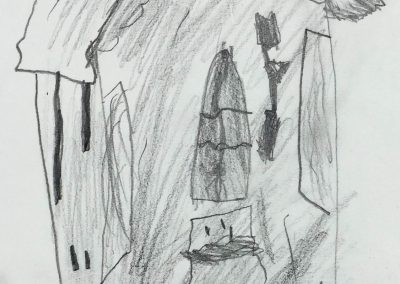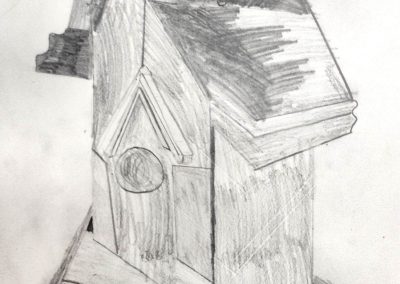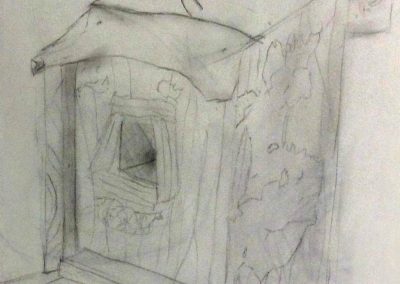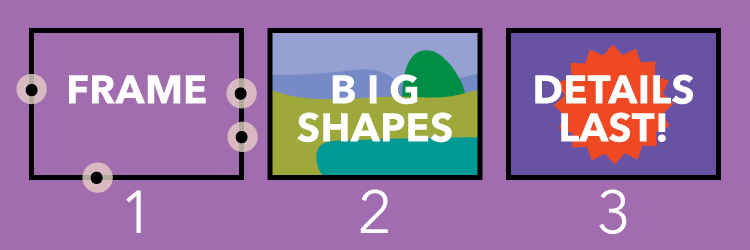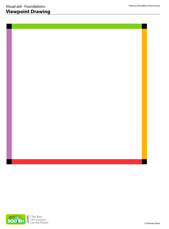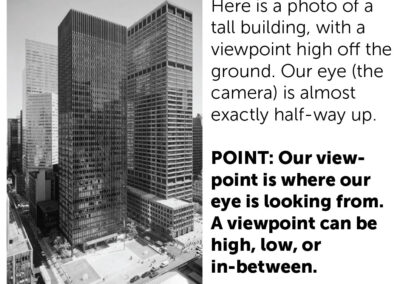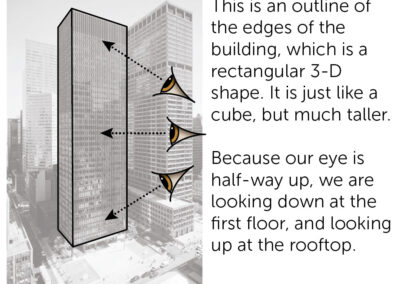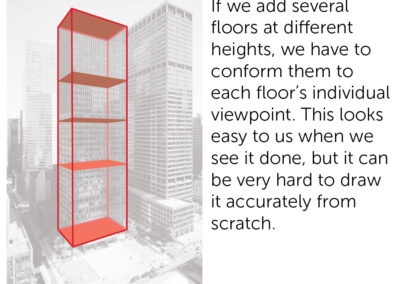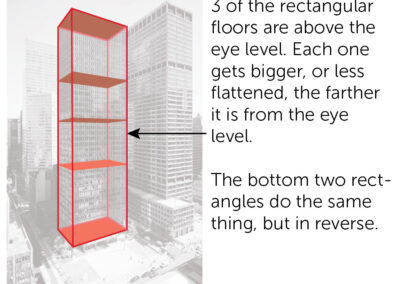Drawing
Each lesson Plan focuses primarily on one of the 4 Cornerstones of Art:
Drawing | Painting | Color | Style
OVERVIEW
Students will create a detailed drawing of an old weathered birdhouse. If possible, the birdhouses used should be real-life objects, but photos are provided. Steps for preparing, using the 3 steps to accuracy, making guide-lines, and pencil techniques are all practiced to create a finished work. A few fun short projects for early finishers are also included.Grades 3 – 5
Week of Oct 27 – 31
1 Hour & 45 Minutes
Lesson At A Glance
A brief overview of each step. Buttons jump to each section for detailed information.
10 Minutes – birdhouse sketch & intro
15 Min – Fact vs viewpoint: cube & stool
12 Min – Flatter slideshow & exercise
8 Min – Smaller trees & fingers
10 Min -Trace birdhouse big shapes
10 Min – Guidelines & erase
35 Min – Pencil drawing
5 Min -Everyone helps
SCROLL & TEACH
LESSONPLAN
Each section is a different color. Read over once and then you can SCROLL & TEACH using any device you like. It’s designed to work best with your phone.
LEARNING TARGETS

Students know how to warm up before creating finished artwork.
M A T E R I A L S
- 14″ x 17″ Sketch Paper
- 2B Pencil
- Oil Pastels
- White Eraser
1.1 Print
Reference
Birdhouse Photos
Two Reference photos to choose from. Print one extra set so every student can choose from either birdhouse photo.
1.2 Warm up
Sketches in black oil pastel.
Have everyone choose one of the two references (Prints are in Step 5) of birdhouses. Use an oil pastel to draw it for practice only.
Explain that they will be drawing in pencil later, so this is just practice, but it is mainly for seeing how to draw the shapes. Draw lines and black areas, but leave gray areas alone.
1.3 Intro
While students work, explain and review. Review the 3 steps to accuracy & talk about how sometimes our brains think things look different than they actually do.
What’s the difference between a camera and a copier machine? [Not much. They both see and reproduce pictures and the are perfectly accurate]
Why can both a camera and a copy machine “draw” so accurately? [Because they only use viewpoint to make their images. They don’t have a brain, and can’t think about the logic of the things they are viewing.]
What’s the difference between a human and a camera? Why can’t we draw as accurately as a camera? [People think about the facts of the objects we’re trying to draw. Because the facts actually get in the way of what we see, it makes it hard to draw what we see.]
Our brains KNOW things. But logical facts are not what our eyes see. Our eyes see things from viewpoints, and every object, every person, and even different parts of objects – always have their own individual viewpoint.
LEARNING TARGETS

Students will know that facts sometimes make drawing things harder instead of easier
2.1 Discuss
Discuss Fact-based drawings vs Viewpoint drawings using a stool. Then display the stool graphic and how silly the facts would make it look!
There are 2 kinds of ways to think about things. Fact-based information, and viewpoint. These two things don’t work together. They are like oil and water, pigs and flying, peanut butter and pickles. They just do not go together.
An artistic drawing is made from a VIEWPOINT. A viewpoint is what the thing we’re drawing looks like from one spot, where your eye is. A Viewpoint drawing of an object is completely different from a fact-based drawing drawing of it.
- A fact-based drawing will NEVER be visually accurate
- A viewpoint drawing will NEVER be factually true”
Look at this picture showing a fact-based stool compared to a viewpoint stool. [below]
Artists don’t try to draw a silly stool like the fact-based one I showed you, but those are true facts, and because we know it’s true, the facts do affect the realism we are trying to create. What we do, is we add a little of the facts into what we see. We compromise a bit. That compromise is what we need to learn to ignore.
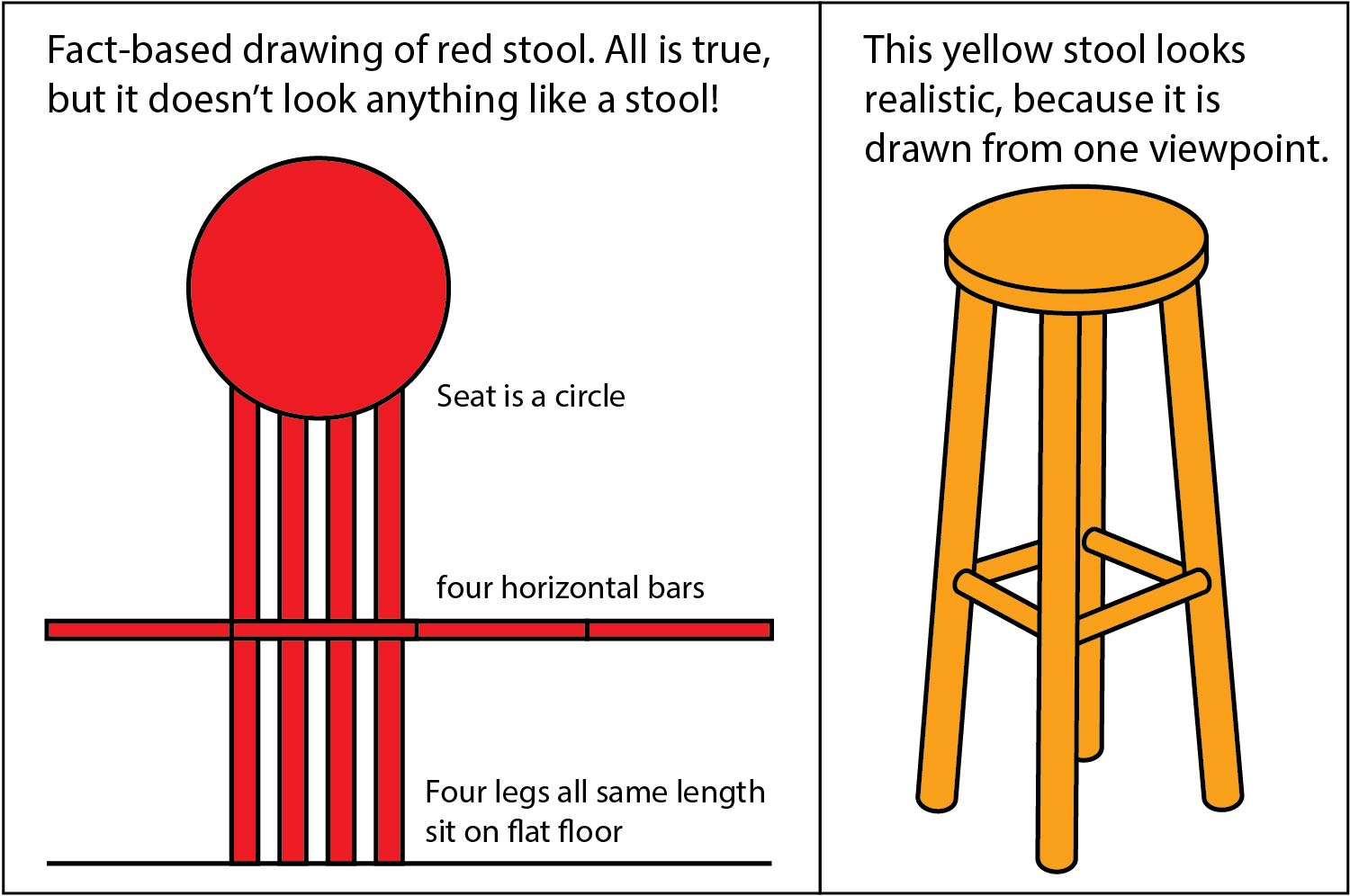
LEARNING TARGETS

Students know that flat things are flatter-looking nearer to eye-level viewpoint
M A T E R I A L S
- Character prints
- Scissors
3.1 Print
Exercise
Viewpoint Characters
Print on CARD STOCK and cut the characters apart. Print one for each student.
Give students a pair of scissors and have them cut from the top of the page, a straight cut line down in-between the two characters, but STOPPING when reaching the bottom of the character’s feet.
Exercise
OPTIONAL to use instead of characters.
Color Sided Square
Print enough for each student to have one – on CARD STOCK.
Use the color-edge square for older kids only.
3.2 Shrink!
Have students cut the paper on the dotted line and stop where the line stops (when it reaches the bottom of the character’s feet). Then have them follow along with these instructions.
- Close one eye.
- Bend the tall cow down and away from you, so that it looks as short as the pig. Now bend more so it’s horizontal but the pig is vertical.
- Now hold the characters steady in that position, and very slowly, keeping one eye closed, raise the paper.
- As you raise it up, notice how the cow gets shorter and shorter, but the pig stays the same!
If using the color-sided square card, DO THIS EXERCISE AFTER THE SLIDESHOW BELOW.
Have students close one eye and move it up and down, noticing how it gets flatte the closer it is to their eye level.
LEARNING TARGETS

Students know things get much shorter as they move away from the viewer
M A T E R I A L S
- 14″ x 17″ Sketch Paper
- 2B Pencil
- 4B Pencil
- White Eraser
4.1 draw
Show students that “Things Get Smaller” by having them draw 2 trees.
Have everyone find a clean sheet of sketch paper in their pad. Then have them draw a tall and skinny simple cartoon tree, and imagine that it is 50 feet high. Now draw another 50 foot tree just like it, that is way, way, way off in the distance.
“Did you draw it the same size? Of course not. Since it’s far away, you made it smaller, because we know that things far away look smaller.
- FACT: the trees are the exact same size
- VIEWPOINT: the trees are completely different sizes.
So the fact and the viewpoint are at total odds with each other. Only one can work in a drawing, and the best one is the viewpoint. Your brain knows that things get smaller by appearance if they are farther away. You cannot change the way that works.
Things get smaller.”
4.2 amaze!
“Now let’s do some magic using sleight of hand. Here is a trick where we make our finger shrink to half its size.
Have everyone hold up their two pointing fingers together in a vertical position about 8-12 inches in front of their face. Even up the tops, and the knuckles so they are right next to each other. Now you have two fingers, or “lines” that are the same height. Close one eye.
Now slowly move one finger away from your eye, just 2 inches. See how fast it shrinks! Now move it away another few inches or so, until it appears to be half the height of the closer one. Don’t move your fingers, but open both eyes. Wow! it’s crazy how much smaller it seems to get in just a few inches, isn’t it?
So you’ve always known things get smaller, but now you know that they get REALLY smaller. This is the viewpoint secret that artists learn for drawing accurately.”
LEARNING TARGETS

Students know how to identify big shapes
M A T E R I A L S
- Tracing Paper
- 14″ x 17″ sketch pad
- Printout of birdhouse
- Ebony pencil
- Oil pastels
- White Eraser
5.1 review
Students will move to the second step in the 3 steps to accuracy.
Have students use their pencil to trace the outline of the birdhouse. Trace the roof lines, the door, the sides, and the base, but no smaller details. These are just the biggest shapes.
Make sure to have students look at their tracing and compare it to what they thought they saw on the photo.
Have them set this up or nearby, and use a bright colored oil pastel to redraw it in their sketch pad nice and big. Just do the same big shape outlines in pastel. They can choose a different color and draw it again.
STEP 6. Guidelines
Students will draw very light guidlines, just like the tracing, but freehand. 10 MinutesLEARNING TARGETS

Students know how to draw guidelines
M A T E R I A L S
- 14″ x 17″ Sketch Paper
- 2B Pencil
- White Eraser
6.1 draw
Students will create light guidelines of Big Shapes for their drawings.
Get a new clean sheet showing in the big sketch pad. Help everyone make their big shapes simple, accurate and light, by moving around the room and offering suggestions.
Guideline drawings can be just like the practice drawings in the last step.
Also work from top to bottom.
LEARNING TARGETS

Students know how to work together and have fun making a silly drawing.
M A T E R I A L S
- 14″ x 17″ sketch pad
- Printout of birdhouse
- Ebony pencil
- Oil pastels
- White Eraser
7.1 draw
Everyone draws their birdhouse using good pencil techniques and taking their time.
This will take some time, depending on your group. Go around the room, finding things you like about what each student is doing. Ask what they like or don’t like, and get permission to offer suggestions for improvements.
7.2 Play
Students can add fun elements to their houses using oil pastels or pencils. Here are some ideas.
• For early finishers, they should use their white and gray oil pastels to color in their birdhouses, mixing the two, and adding black if they want.
• Or have them add birds in pencil – or bright colors – all around and maybe in their birdhouses looking out a window.
• Make your birdhouse a haunted house.
• Decorate your birdhouse for Christmas.
• Add elves or other characters. Be creative.
Students can make a drawing together.
The younger age group will not likely be able to draw for the entire time, and may finish details and shading faster. This part of the lesson is to fill that time with something fun and appropriate for the age level. It’s an awesome artists’ game.
Have everyone arranged around tables in groups of 3 to 6 students each, so that papers can be passed around the group in a certain direction (ie: always pass to the right). Use music to stop and start the drawing. Each person draws a creature part, and then they pass the paper on, and put a new creature part on the paper that’s passed to them. After several rounds, the creatures are very silly and it’s loads of fun.
Rules:
- Nothing can be drawn that will make any parent from the class unhappy. (This communicates perfectly, and will elicit several groans of understanding).
- Only one creature part can be drawn per turn. Parts that come in pairs, like eyes or hands, can be drawn as one part, or two. An arm or leg is a separate part though.
- You cannot intentionally ruin a drawing.
- Leave open spots for additional parts, such as tails, wings, noses, hair, etc.
- You cannot draw the same creature part on more than one drawing (such as a trunk on every one).
- Take a second each turn, to decide what would look good for this drawing. You are artists. Please act like it. Only artists can play this game well.
The first student should write their name on their paper (small). Then start the drawing by adding one creature part. When the music stops, pass to the next person. When you get a new drawing, add your name above the one before until your name is on each drawing in your group. Stop the music when you notice that most students are finished or nearly so, making sure the slow artists are not getting cut short too much.
Everyone keeps the drawing that has their name at the bottom which they began with, but students are free to trade if everyone is ok with it.
If you had a very short drawing time and finish the game early, have everyone color the crazy creature with oil pastels (or markers or colored pencils, if you have them).
LEARNING TARGETS

Students know the importance of cleaning up
M A T E R I A L S
- Paper Towels
- Cleaning wipes
- Sink
- Waste baskets
- Well-lit spot for photos
- Camera or phone-camera
8.1 clean
- Wash hands
- Super-wash brushes if used
- Put art supplies away
- Wipe tables & toss trash
- Remove any smocks (last)
- Check for items on floors and tables
8.2 photo
OBJECTIVES
- Practice and improvement using insights and techniques recently learned
- Understanding how to prepare for, and create, a detailed pencil drawing
- Accomplishment in drawing and shading more realistically
- Fulfillment by using new skills competently
TROUBLESPOTS
Haste – This kind of work takes a calm, slow, and deliberate approach. some artists tend to want to work only expressively. It’s ok to work in your tendencies, but it is important to develop multiple methods, especially a controlled and realistic drawing style. The best expressionists have worked in a very planned and deliberate way.
Lack of contrast – It’s not easy to look at colors and values, and many young artists will create work that has the same light or medium tone everywhere. Be on the lookout for this, and encourage students to leave the light areas very light, and create good medium tones and dark areas too. Without contrast, a pencil drawing does not command much attention.
Transfering measurements – This one is very important!
Measuring with a pencil in Step 4 helps so much, but young students have a hard time understanding proportion. You will probably see many kids trying to use the exact same measurements from holding their pencil up, and placing it right onto the paper, without enlarging the measurements. Make sure that you explain how it is proportions that you are getting, not exact measurements AND be on guard for this happening.
Classic problems – with the cube shape – The bottom of any rectangular solid will tend to be flattened out by almost every artist. We’ve included the 3 cube tricks from last week, and that should help, but still, be prepared to help students change the structure of their cube shapes to be more accurate. Most often this entails bringing the front point (at the bottom center) much lower, and to create more of a V shape at the bottom, with the two base lines of the cube shape having a stronger V angle.
ART WORDS
Accuracy – When we want things to look realistic, we are striving for accuracy in our drawing abilities. Many people use phrases like, “it looks right”, instead of “it looks accurate”. Using the words right and wrong tend to make artists who are learning accuracy, feel like they’re not true artists. We avoid these terms and say accurate instead.
Frame – The ArtSquish term to denote the edges of a work of 2-dimensional art. Usually a rectangle or square.
Big Shapes – The ArtSquish term to denote the 4 to 6 largest shapes in a work of art. Most images can be divided into just a few of these very large shapes, which will intersect the frame on more than one side.
CLASSROOM
PREP
Print all of your PDFs from the lesson plan and cut any references apart as needed.
What your room needs
Here are your printable lists and room prep instructions.
CLASSROOM
MATERIALS
- Paper towels
- PDFs
- 3D Birdhouses to draw OR PDF
- Cleaning Wipes
- Sink
- Waste Baskets
- Well-lit spot for photos
- Camera or camera-phone
- Smocks
STUDENT’S
MATERIALS
- 14” x 17” Sketch Paper
- 2B Pencil
- 4B Pencil
- White eraser
- Charcoal
- Kneaded Eraser
- Ebony Pencil
PREVIEW
Week 14: Patches Watercolor
Students will create a square-shaped watercolor, that is divided into a grid design. Each smaller area (rectangles and squares), becomes a tiny little painting, drawn and painted in watercolors. This will employ the small glaze technique, and makes it easy since there are no large areas to worry about. The whole work is made up of painting patches, and each painting is made up of patches of color.
Week 15: Patching Up & Charcoal
Students will finish the little patches watercolor they began last week. As students finish, they’ll begin work in charcoal, warming up with quick sketches and using several photo references. Oil pastels are introduced to create a black and white mixed media, and then color is added for a monochromatic work. There is an in-depth charcoal demo too.

